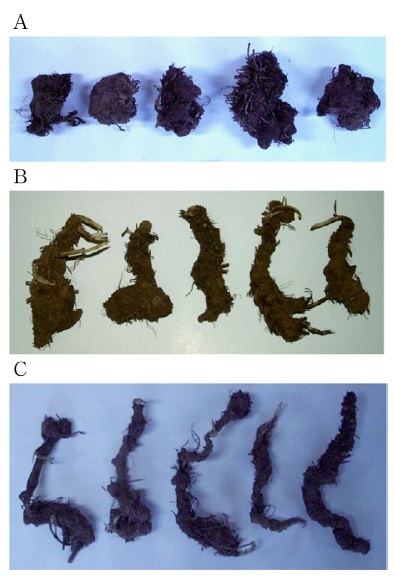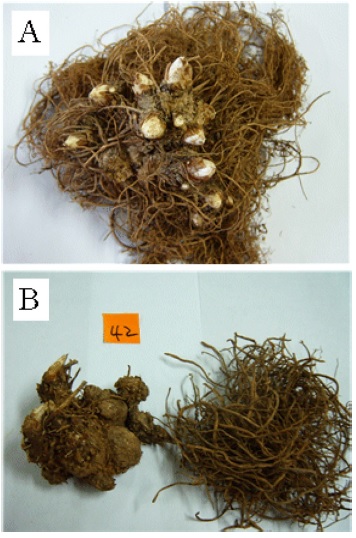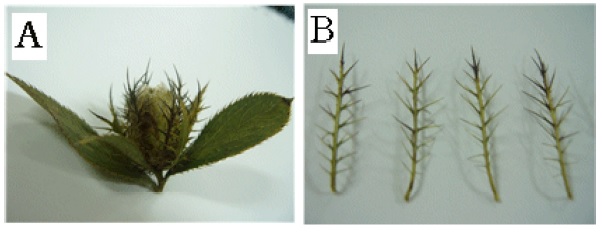
삽주 수집자원의 생육 특성 및 Sesquiterpenoid 함량 변이
This is an open access article distributed under the terms of the Creative Commons Attribution Non-Commercial License (http://creativecommons.org/licenses/by-nc/3.0/) which permits unrestricted non-commercial use, distribution, and reproduction in any medium, provided the original work is properly cited.
Abstract
This study evaluated the local germplasm of Atractylodes japonica Koidz. and investigated the individual variation of growth characteristics and sesquiterpenoid contents.
Overall, seven local germplasm were collected in Korea. Sesquiterpenoids, atractylenolide III (AT3) and atractylon (ATLN), were analyzed quantitatively using higher performance liquid chromatography to evaluate the rhizome quality of each germplasm. The Haenam local population (n = 57) was maintained in an experimental field, and growth characteristics such as numbers of flowers, stem and leaves, inflorescence size, stem length, rhizome weight, and sesquiterpenoid contents were investigated. The local germplasm from Jeongsun, Youngcheon, and Haenam had higher amounts of AT3 and ATLN than those from Munkyung, Hamyang, Hadong, and Wando. The Haenam local population was grouped individually by the leaf type and by rhizome shpape. Individual level variation in the Haenam local population was relatively large in sesquiterpenoid contents and growth characteristics except in the sizes of inflorescence and involucre. Shoot growth characteristics were positively correlated with rhizome weight, but lacked correlation with sesquiterpenoid contents. There were no differences among AT3 and ATLN contents in plants with different leaf type, and rhizome shape, and plants with compound leaves of trifoliate and pentafoliate had larger shoot growth.
Local germplasm of A. japonica had large variation in growth characteristics and sesquiterpenoid contents, and plants with greater shoot growth and compound leaves have potential for higher rhizome yield.
Keywords:
Atractylodes japonica Koidz., Individual Variation, Leaf Type, Local Germplasm, Rhizome Shape, Sesquiterpenoid서 언
삽주 (Atractylodes japonica Koidz.)는 국화과 (Asteraceae)에 속하는 다년생 초본식물이며, 지하부 근경은 생약 (백출)으로 이용되고 있다. 국가표준식물목록은 삽주의 학명을 A. ovata (Thunb.) DC.로 기록하고 있으며, A. japonica (Koidz.) Kitag.를 이명으로 처리하고 있다. 한약재 백출 (白朮)은 보기약 (補氣藥)으로 위장보호, 소화촉진 등의 약리효과를 가지며, 국내 자생종인 삽주 이외에 도입종인 큰꽃삽주 (A. macrocephala Koidz.)를 기원으로 하고 있다 (MFDS, 2019).
삽주 근경에는 정유성분으로 atractylon, atractylenolide I, atractylenolide II, atractylenolide III 등과 같은 sesquiterpenoid 성분이 주로 함유되어 있으며 (Yim et al., 1988; Tang and Eisenbrand, 1992; Chung et al., 2004), sesquiterpenoid 성분은 leukemia cell에 세포독성을 나타내거나 항염 및 진통효과가 있어 (Wang et al., 2002; Chen et al., 2016), 삽주 품질요소로서 sesquiterpenoid 함량을 HPLC나 GC를 이용해 분석하여 평가하고 있다 (Fukuda et al., 1998; Suto et al., 1998; Wang et al., 2006; Yun et al., 2013).
삽주는 일가화로 타가수정식물이고, 삽주 집단은 양적형질의 변이가 크며 삽주속 (Atractylodes) 식물의 잎 형태는 단엽과 장상복엽 (3 출엽)이 주로 존재하였고 엽형은 타원형이 가장 많았다고 하였다 (Park et al., 2000; Kim et al., 2002). 국내 삽주의 유전적 다양성과 집단구조에 대한 연구결과에서 삽주 집단은 비교적 높은 다양성을 나타난 것으로 보고하고 있다 (Huh et al., 2002).
국내 자생종 삽주는 주당 근경 수량이 도입종 큰꽃삽주보다 낮으나 습해와 근부병에 강한 특성이 있는 것으로 알려져 있으며 (Cho et al., 2001), 최근에는 큰꽃삽주와 삽주를 교배한 잡종세대에서 우량개체를 선발하여 육성한 품종들이 보급되고 있다 (Jeong et al., 2018). 삽주는 중국에서 창출 (蒼朮)로 사용되기도 하며, 큰꽃삽주보다 atractylon과 atractylenolide III 함량이 높고 (Kim et al., 2006; Chen et al., 2016) 내병성과 내습성이 비교적 강한 장점을 가지고 있어 삽주의 재배 기술이나 우량계통을 개발하여 이용성을 높일 필요가 있다.
국내 자생 삽주에 대한 재배연구로 자생지의 환경과 생육특성을 조사하여 남부지역 자생종이 초장, 엽수 등 지상부 생육이 중부지역 자생종보다 높았으나 수량은 경기, 강원지역이 높았다는 결과 (Park et al., 2000)와 멀칭방법, 차광 및 화뢰제거, 어린 순 채취 및 질소 시비에 따른 근경 수량을 조사한 결과들이 있으나 (Jang et al., 1996; Park et al., 2004a; Park et al., 2004b), 국내 자생 삽주와 관련된 연구는 큰꽃삽주에 비해 적은 편이며 유전분석이나 육종 연구도 매우 미진한 편이다.
본 연구는 국내 자생삽주를 지역별로 수집하여 성분 분석 및 생육 특성을 조사하여 수집종들 간의 차이와 수집집단 내 개체변이를 파악하고 삽주 우량계통 육성을 위한 기초자료로 이용하고자 수행하였다.
재료 및 방법
1. 실험재료
본 시험에 사용된 삽주 (Atractylodes japonica Koidz.)는 강원도 정선, 경상북도 문경, 영천, 경상남도 함양, 하동, 전라남도 해남, 완도 등 7 개 지역에서 수집하였다. 수집된 삽주 유전자원은 줄기 수가 두 개 이상으로 2년생 - 3년생으로 추정되었으며 각 수집자원들의 근경은 성분 분석에 사용하였다. 정선과 해남 수집자원은 근경 모양 및 크기별로 구분하였으며, 문경, 영천, 완도 수집자원은 잎 형태별로 구분하여 비교하였다. 수집자원 중 잎이나 뿌리 형태가 다양하였고 수집된 개체 수가 많았던 해남 수집자원은 60 여 개체를 별도로 시험포장에 재식하여 3 년 동안 유지한 후 식물체 생육 특성을 조사하였으며 10월에 근경을 수확하여 성분 분석에 사용하였다.
근경 모양은 대체로 둥근 모양인 구형 (round rhizome, R), 둥글면서 긴 모양인 장구형 (long round rhizome, LR), 가늘고 길면서 마디로 연결된 모양인 연주형 (long rhizome with nodes, LN) 등으로 구분하였으며 (Fig. 1), 엽형은 잎 하나로 된 단엽 (simple leaf, S), 작은 잎 세 개로 된 삼출엽 (trifoliate leaf, T), 그리고 작은 잎이 다섯 개로 된 오출엽 (pentafoliate leaf, P) 등으로 구분하여 집단 내 개체들의 생육 특성 및 성분함량을 비교하였다.
2. 생육특성조사
해남 수집자원은 60 여 개체를 수집 후 유지하면서 생육 특성 및 성분함량 등에 대한 개체변이를 조사하였고, 주요 생육 특성은 화기, 경엽, 지하부로 구분하여 나타냈다.
화기 특성으로 꽃의 색깔, 꽃의 개수, 꽃의 길이와 너비, 총포의 길이와 너비를 조사하였는데, 꽃의 개수는 한 식물체에 개화된 꽃의 수를 나타내며, 화경에 붙은 꽃과 총포 전체의 길이와 너비를 측정하였다. 경엽 특성으로 경장, 경수, 분지수, 마디수, 엽수, 엽면적, 엽장폭비, 엽병길이 등과 엽형을 조사하였으며, 지하부 특성에서는 근경 모양 이외에 근경중, 근중 등을 조사하였다. 경장은 지제부로부터 주경의 화경까지의 길이이며, 경수는 한 식물체에서 나온 줄기의 수이고, 분지수는 한 줄기에서 발생된 분지의 수이며, 마디수는 한 줄기에 있는 마디의 수를 조사한 것이다. 엽수는 한 식물체에 있는 전체 잎의 수이며, 엽면적은 잎의 길이와 너비를 곱하여 2로 나눈 값이고, 엽장폭비 (W/L ratio)는 잎 길이에 대한 잎 너비의 비를 나타낸 값이다.
복엽인 삼출엽이나 오출엽은 가장자리에 붙은 잎을 대상으로 조사하였으며 한 식물체에 붙은 잎 중 5 개를 무작위로 선택하여 측정하고 평균하였다. 지하부 무게는 수확하여 전체 생중을 측정한 후 뿌리와 근경을 분리하여 각각의 무게를 측정하였다 (Fig. 2).
3. Sesquiterpenoid 분석
수집 삽주자원들과 해남 수집집단 내 개체들의 근경에 함유된 주요 sesquiterpenoid 성분인 atractylenolide III (AT3)와 atractylon (ATLN)의 함량을 High Performance Liquid Chromatography (HPLC)를 이용하여 분석하였다.
정량을 위한 표준물질 AT3는 Wako Pure Chemical Industries (Osaka, Japan)에서 구입하였으며, ATLN은 hexane 용매 분획과 칼럼크로마토그래피 (open column chromatography)를 수행하여 물질 분리하였다. 분리된 ATLN의 화학구조는 MS와 NMR 분석으로 동정하였으며, NMR 스펙트럼과 HPLC-DAD 크로마토그램의 피크 면적으로 99.0% 이상의 순도를 확인하고 표준물질로 사용하였다.
분석 시료인 근경은 60℃에서 건조한 후 절단 및 분쇄되었으며 분쇄된 가루 시료의 추출은 3 회 반복하여 시험하였다. 분쇄된 가루는 반복 당 2 g을 정밀히 달아 80% 메탄올 30 ㎖로 상온에서 1 시간씩 100 rpm 정도로 3 회 진탕 추출하고 최종부피를 100 ㎖로 맞추었다. 추출액 50 ㎖는 농축하여 엑스함량 (80% methanol extract)으로 측정하고 나머지 추출액은 1 일 동안 냉동실에 저장한 후 상등액 1 ㎖를 취하여 HPLC 분석 시료액으로 사용하였다.
분석시험에 사용된 HPLC (Agilent 1100 Series, Agilent Technologies Inc., Santa Clara, CA, USA)의 조건은 역상 칼럼인 Capcell Pak 18 UG 120 ( 5 ㎛, 4.6 ㎜ × 150 ㎜, Shiseido Co., Osaka, Japan)을 사용하였고 UV 검출기 (Agilent 1100 Series, Diode Array Detector)는 220 ㎚에서 측정하였다. 이동상은 50% acetonitrile 용액을 40 분 동안 90% acetonitrile 용액으로 분당 1 %로 증가시키는 조건이며, 이동상 유속은 1.0 ㎖/min이었다. 시료 당 분석 시간은 칼럼 세척시간을 포함하여 총 60 분으로 하였다.
4. 통계분석
수집자원에 대한 측정값은 평균과 표준편차 (mean ± SD)로 나타냈고, 실험군 간의 통계분석은 SPSS 프로그램 (IBM SPSS Statistics, Ver. 27, IBM Co., Armonk, NY, USA)을 사용하였다.
실험군 간의 측정치 비교는 Duncan’s Multiple Range Test (DMRT) 방법으로 5% 유의수준에서 통계적 유의성을 검정하였다. 두 실험군 간 평균비교는 t-test (p < 0.05)를 통해 유의성을 검정하였고, 주요 특성들 사이의 상관분석은 Pearson 상관계수를 계산하여 유의성을 확인하였다.
결과 및 고찰
1. 삽주 수집자원의 sesquiterpenoid 함량
삽주 수집자원의 sesquiterpenoid 함량을 조사하기 위해 HPLC 분석을 하였고 시료 추출물과 표준물질의 크로마토그램을 비교하여 정량하였다 (Fig. 3). 표준물질 AT3과 ATLN의 검량선은 각각 0.085 - 0.339 ㎎/㎖와 0.022 - 0.522 ㎎/㎖의 농도 범위에서 작성하고 직선회귀식의 유의성 (r2 = 0.9998***과 r2 = 0.9999***)을 확인하여 정량하였다. HPLC 크로마토그램에서 AT3과 ATLN의 머무름 시간 (retention time, RT)은 각각 6.3 분과 28.1 분이었다.
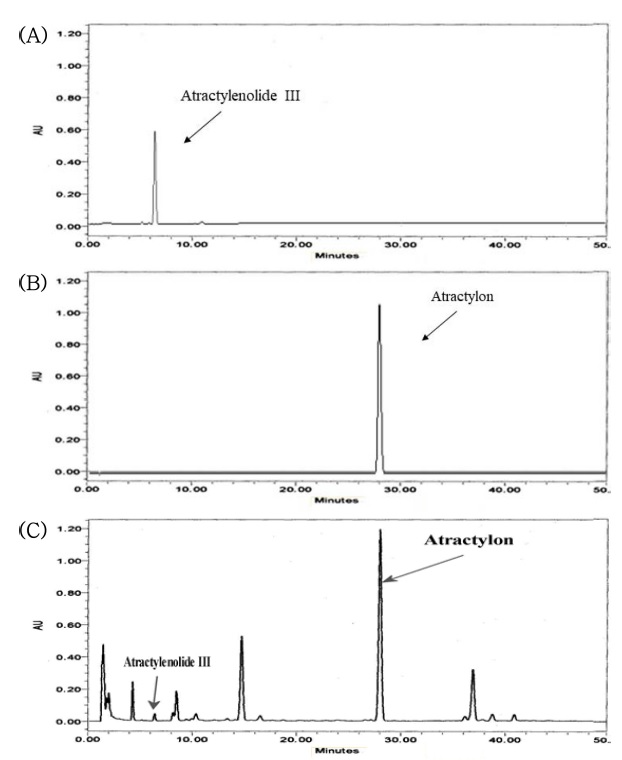
HPLC chromatogram of atractylenolide III (A), atractylon (B), and 80% methanol extract (C) from Atractylodes japonica rhizome.
국내 7 개 지역에서 수집된 삽주자원의 근경에 함유된 sesquiterpenoid 함량 분석 결과는 Table 1과 같다.

Differences of sesquiterpenoid contents in rhizomes of Atractylodes japonica Koidz. local germplasm collected from different areas in Korea.
분석된 AT3과 ATLN 함량은 정선 0.55 ㎎/g, 1.73 ㎎/g, 문경 1 .07 ㎎/g, 0.81 ㎎/g, 영천 1 .1 0 ㎎/g, 0.96 ㎎/g, 함양 0.26 ㎎/g, 0.94 ㎎/g, 하동 1 .36 ㎎/g, 0.51 ㎎/g, 해남 0.54 ㎎/g, 1.55 ㎎/g, 그리고 완도 0.42 ㎎/g, 0.46 ㎎/g으로 각각 나타났다. 두 성분을 합한 총량에서 정선, 영천, 해남 수집자원이 0.20 ㎎/g 이상 상대적으로 높았으며 함양과 완도 수집자원은 낮은 함량을 보였다.
또한 수집자원들 간의 성분조성은 일정하지 않았는데, 정선, 함양, 해남, 완도 등 수집자원은 ATLN 함량이 AT3 보다 높았고 문경, 영천, 하동 등 수집자원은 AT3 함량이 ATLN보다 높게 나타났다. 이는 sesquiterpenoid 생합성 경로에 관여하는 유전자나 환경요인에 의해 축적량이 달라지는 것으로 추정할 수 있으나 좀 더 자세히 검토되어야 할 것으로 보인다.
대체적으로 수집자원들의 ATLN과 AT3 함량이 재배종보다는 비교적 높은 함량을 나타냈다 (Kim et al., 2006). 수집자원들 간의 상대적 차이는 수집된 자생지역이나 생육 특성에 의한 것이지만 자생지에서 생육 년령의 차이에 의한 것으로 추정된다 (Park et al., 2000).
정선 수집자원은 근경의 크기를 상대적으로 큰 것과 작은것으로 구분하고 근경의 모양을 구형 (R), 장구형 (LR), 연주형 (LN)으로 구분하여 sesquiterpenoid 함량을 분석하였다 (Table 2). 전체적으로 ATLN 함량은 근경이 큰 것이 작은 것보다 높았고 AT3 함량은 근경이 작은 것이 더 높은 경향이었으며, 총량에서는 근경이 큰 것이 작은 것보다 높은 함량을 나타냈다.

Changes of sesquiterpenoid contents by different rhizome shape and size in Jeongsun local germplasm of Atractylodes japonica Koidz.
근경의 모양별 sesquiterpenoid 함량은 구형에서 가장 높았고 연주형에서 가장 낮게 나타냈는데, 이러한 결과는 생육 습성이나 재배지의 토양특성에 따라 삽주 근경의 모양이 달라지며 같은 근경에서도 부위에 따라 성분함량이 다르다는 결과와 비슷하였으며 (Fukuda et al., 1998), 구형 근경이 장구형이나 연주형보다 상대적으로 섬유질이 적고 육질이 많기 때문인 것으로 생각된다.
해남 수집자원에서 근경의 모양에 따른 성분함량 차이를 보면, 전체적으로 ATLN 함량이 AT3 보다 높았으며, 총량에서 구형 (R) 2.18 ㎎/g과 장구형 (LR) 2.41 ㎎/g은 연주형 (LN) 1.62 ㎎/g 보다 높게 나타났다 (Table 3). 그러나 정선 수집자원에서는 장구형이 가장 낮고 구형이 가장 높았으나 (Table 2) 해남 수집자원에서는 장구형이 구형보다 다소 높은 편이었다. 삽주의 구형 근경은 모양이 둥글지만 완전한 구형보다는 여러개의 덩어리가 뭉친 형태를 가지고 있어 뚜렷한 모양을 갖기 어렵고, 덩어리를 이어주는 가는 부분은 섬유질이 대체로 많은 부분이어서 근경의 모양에 따라 성분함량도 차이를 보이는 것으로 판단된다.

Changes of sesquiterpenoid contents by different rhizome shape in Haenam local germplasm of Atractylodes japonica Koidz.
재배 토양이나 재배 방법에 따라 근경의 모양은 달라질 수 있으므로 근경의 모양별로 삽주 자원을 구분하여 선발하기는 어렵지만 구형이나 장구형의 근경이 성분 함량 면에서는 유리한 것으로 생각된다.
삽주는 식물체 줄기 상위절에 단엽이 달리며 중위절에 삼출엽, 하위절에 오출엽이 달리는 특성을 갖고 있지만 개체별로 엽형의 차이가 있었다. 대체적으로 단엽을 갖는 개체 (S)는 전체 줄기에 단엽이 달리며 삼출엽을 갖는 개체 (ST)는 상위절에 단엽이 있으며 오출엽을 갖는 개체 (STP)는 삼출엽과 단엽이 동시에 달리는 특성을 가지고 있었다 (Fig. 4). 삽주와는 다른 종인 큰꽃삽주 (A. macrocephala Koidz.)에서 좁은 잎과 넓은 잎을 가진 개체들이 있으며 상위엽은 단엽이고 중하위엽은 삼출엽이나 오출엽을 가진 개체들이 관찰되었고 (Fukuda et al., 1997), 국내 삽주 수집자원들에서도 단엽, 삼출엽, 오출엽이 동일 집단 내에서 혼재하는 결과가 보고되기도 하였다 (Kim et al., 2002).
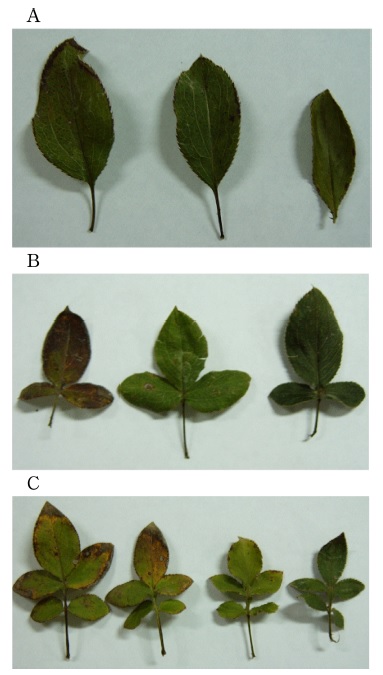
Leaf types with different number of leaflets in Atractylodes japonica Koidz.A; simple leaf (S), B; trifoliate leaf (T), C; pentafoliate leaf (P).
완도, 문경, 영천 등 수집자원의 경우, 수집될 때의 엽형에 따라 개체들을 구분하고, 근경에 함유된 성분함량을 조사하였다. 완도와 문경 수집자원은 단엽 개체들의 sesquiterpenoid 함량이 높았고 영천 수집자원에서는 삼출엽 개체들에서 높게 나타났으나, 문경 수집자원의 성분함량은 엽형 간 유의한 차이를 나타내지 않았다 (Table 4). 이와 같이 엽형과 성분함량과의 관계는 일관성을 나타내지 않았으며 다른 생육 특성과 재배 환경의 영향이 더 큰 것으로 보인다.
2. 해남 수집집단의 생육특성 및 sesquiterpenoid 함량의 개체 간 차이
해남에서 수집된 삽주자원 (n = 57)은 개체별로 재배포장에서 재배한 후 화색, 근경 모양, 엽형 등과 화기, 경엽, 지하부 등의 생육특성을 조사하였으며, 근경에 함유된 sesquiterpenoid 함량을 개체별로 분석하였다.
삽주의 화색은 보통 흰색 (white)이지만 옅은 적자색 (redpurple)을 띄는 개체도 1 1% 정도 관찰되었으며, 큰꽃삽주의 화색보다는 더 옅은 적자색을 나타냈다. 근경 모양에서 연주형 (LN)은 보이지 않았으며 구형 (R)이 66%, 장구형 (LR)이 34% 정도였는데 뚜렷이 구분하기 어려운 개체도 있었다. 엽형에서 단엽 개체 (S)가 37%, 단엽을 포함하는 삼출엽 개체 (ST)는 38%, 그리고 단엽과 삼출엽을 포함하는 오출엽 개체 (STP)가 25% 정도 분포하는 것으로 보아 삽주의 엽형과 근경모양이 다양하다는 것을 알 수 있었다 (Fig. 5).
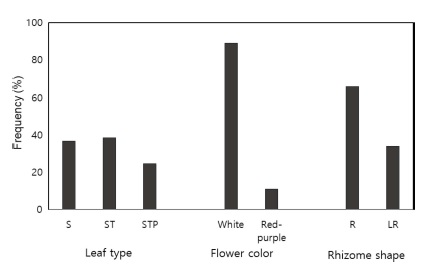
Frequency distribution for leaf type, flower color and rhizome shape in Haenam local population (n = 57) of Atractylodes japonica Koidz.S; plant with simple leaf, ST; plant with simple and trifoliate leaves, STP; plant with simple, trifoliate and pentafoliate leaves. R; plant with round rhizome, LR; plant with long round rhizome.
해남 수집자원에서 화서의 크기를 개체별로 조사한 결과, 화서의 길이가 1 .75 ㎝, 너비는 0.74 ㎝로 비교적 작았고, 화서밑에 붙은 꽃받침 (포엽)으로 구성된 총포는 크기와 너비가 다양한 여러 개 포엽이 있었으며 안쪽 포엽은 가늘고 긴 가시모양을 나타냈다 (Fig. 6). 안쪽 포엽의 길이와 너비는 1 .75 ㎝, 0.66 ㎜를 각각 나타냈고 총포길이는 화서길이와 비슷하였다. 식물체 당 4.2 개 정도인 꽃의 수에 대한 변이계수 (67.1%)는 화서나 총포의 크기에서 보다 더 크게 나타냈다 (Table 5). 꽃은 분지의 말단 부분에 착생하므로 줄기나 분지의 발달 등 생육 정도에 따라 꽃의 착생수가 달라져 변이 폭이 클 수 있으며 화서나 총포는 상대적으로 변이가 작음을 알 수 있었다.

Mean, standard deviation and coefficient of variation of flower characteristics in Haenam local population (n = 57) of Atractylodes japonica Koidz.
해남 수집자원의 경엽특성을 조사한 결과, 경장 22.3 ㎝, 경수 3.5 개, 분지수 4.2 개, 마디수 10.7 개, 엽수 2 1 .4 개였으며, 엽면적은 7.7 ㎠이고 엽장폭비는 0.48로 나타냈다 (Table 6). 엽병의 경우 같은 식물체내에서도 엽병이 있는 것과 없는 것이 함께 관찰되기도 하였는데, 엽병이 없는 개체는 30% 정도로 보통 단엽 개체들에서 관찰되었고 엽병이 있는 개체들의 엽병길이는 1.13 ㎝로 나타났다. 경수, 분지수, 엽수, 엽병길이 등의 특성에서 변이계수가 경장, 마디수, 엽장폭비, 엽면적 등에서 보다 비교적 높게 나타났다.

Mean, standard deviation and coefficient of variation of shoot characteristics in Haenam local population (n = 57) of Atractylodes japonica Koidz.
본 연구에서 해남 수집집단의 엽장폭비는 다른 형질들에 비해 상대적으로 변이계수가 작았고 잎 모양에서 큰 차이를 구분하기 어려웠다. 그러나 Kim 등 (2002)은 엽장폭비를 기준으로 수집 삽주자원의 잎 모양을 난형, 타원형, 도피침형으로 구분하고 타원형이 가장 많았다고 보고하였는데 본 시험에서도 엽장폭비를 기준으로 잎 모양별로 구분하고 비교할 수 있을 것으로 생각된다.
해남 수집자원의 지하부 특성과 sesquiterpenoid 함량 분석 결과는 Table 7과 같다. 지하부 무게는 48.3 g이었고 근경과 뿌리는 각각 38.7 g, 9.6 g이었다. 엑스함량은 15.8%이었고, 성분함량에서 AT3 0 .21 ㎎/g, ATLN 0.41 ㎎/g, 총량 0.62 ㎎/g을 보였다. 변이계수는 엑스함량이 48.8%이며 근경 특성과 sesquiterpenoid 함량에서 70.0% 이상으로 나타났다. 변이계수를 기준으로 화기나 경엽 등 지상부 형질보다는 지하부형질의 개체 간 차이가 더 크게 나타났음을 알 수 있었다. 이러한 결과는 큰꽃삽주 (A. macrocephala Koidz.)의 1년생 근경에서 ATLN의 함량이 2년생보다 높았지만 AT3 함량은 낮은 것으로 나타나 생육 년령에 따라 차이가 있었으며, 1년생보다 2년생 개체들이 전반적으로 생육량이 많았고 개체 간 차이가 더 크게 나타났다는 결과와 유사하였다 (Fukuda et al., 1997).

Mean, standard deviation and coefficient of variation of sesquiterpenoid contents and fresh weights of underground parts in Haenam local population (n = 57) of Atractylodes japonica Koidz.
수집하여 재배된 해남 수집집단의 성분함량은 전반적으로 수집 당시의 결과보다 다소 낮게 나타났는데 (Table 1), 이는 대체적으로 시호, 도라지, 인삼 등 약용식물에서 생육 년령이 높을수록 약리성분의 함량이 낮으며 자생지나 재배지 등 생육환경에 따라 약리성분의 함량 차이가 나타나기 때문인 것으로 생각된다 (Seong et al., 1994; Park and Chae, 1996; Kim et al., 1999; Moon et al., 2019). 따라서 생육 년령이 높아지고 재배환경의 변화에 따라 함유성분의 함량 차이가 난 것으로 생각되며, 오래된 삽주의 근경은 육질보다는 섬유질이 많아짐에 따라 성분함량의 차이를 가져온 것으로 추정할 수 있었다.
이러한 생육 형질이나 성분함량에 대한 개체 간 차이가 유전적 요인에 의해 어느 정도 영향을 받았는지는 후대검정을 통해 확인하여야 하며, 한 개체로부터 분주하거나 종자번식을 통해 환경변이와 유전변이를 파악하면서 선발하여야 할 것으로 보인다.
해남 수집집단에서 엽형을 기준으로 개체들을 구분하여 생육 특성과 성분함량을 비교하였는데, 오출엽 개체들이 단엽이나 삼출엽 개체들보다 꽃의 수가 더 많았다. 그러나 화서나 총포의 크기에서는 엽형별로 유의한 차이를 보이지 않았다 (Table 8).

Differences of flower characteristics by leaf type in Haenam local population (n = 57) of Atractylodes japonica Koidz.
경엽 특성 중 경장, 분지수, 마디수, 엽수 등에서 단엽, 삼출엽, 오출엽 순으로 높게 나오는 경향을 보였으며, 단엽 개체들은 엽병이 거의 없었고 엽병이 관찰된 오출엽과 삼출엽의 엽병길이는 차이를 나타내지 않았다. 잎의 장폭비는 유의한 차이는 없었지만 단엽 (0.50)에서 삼출엽 (0.48)이나 오출엽 (0.46)보다 더 크게 나타났으며, 이러한 결과는 단엽의 모양이 상대적으로 더 둥글고 넓은 경향을 보인다고 해석할 수 있었다. Kim 등 (2002)은 엽장폭비를 기준으로 삽주 수집자원들의 잎 모양을 난형, 타원형, 도피침형으로 구분하기도 하였는데, 이는 추후 본 시험의 엽형별 장폭비 결과와 비교하여 잎 모양의 구분 기준을 새로이 설정할 수 있을 것으로 생각된다.
엽형별로 경장, 줄기수, 마디수, 엽수 등을 비교할 때 전반적으로 오출엽 개체들이 경엽 생육량이 많았음을 알 수 있었다. 식물체 총 엽면적은 엽면적과 엽수를 곱하여 나타냈는데, 단엽 개체는 144.7 ㎠, 삼출엽은 141.5 ㎠ 정도인 반면 오출엽은 207.0 ㎠으로 가장 큰 엽면적을 나타내 경엽 생육량이 많은 특성과 비슷한 경향을 보였다 (Table 9).

Differences of shoot characteristics by leaf type in Haenam local population (n = 57) of Atractylodes japonica Koidz.
지하부 특성의 경우, 지하부 무게와 근경중에서 엽형별 차이를 보이지 않았으나 삼출엽과 오출엽 개체들이 단엽 개체들 보다 더 높은 경향을 나타냈다. 그리고 엑스함량, AT3과 ATLN 함량에서도 엽형에 따른 차이는 보이지 않았다 (Table 10). 국내 16 개 지역에서 수집된 삽주자원들의 엽형은 단엽 (simple leaf)과 복엽 (compound leaf)으로 구분되었고 복엽은 우상복엽과 장상복엽으로 구분되었는데, 우상복엽에서 2 출엽 (bifoliate of pinnately compound leaf)과 3 출엽 (trifoliate of pinnately compound leaf), 장상복엽에서 3 출엽과 5 출엽 (pentafoliate of palmately compound leaf)으로 구분하기도 하였다 (Kim et al., 2002). 이처럼 본 연구에서 조사된 삽주자원에서 보다 더 다양한 엽형이 분포하는 것으로 보고하였는데, 잎의 형태변이가 환경에 의한 것인지 또는 유전에 의한 것인지를 확인할 필요가 있었다.

Differences of sesquiterpenoid contents and fresh weight of underground part by leaf type in Haenam local population (n = 57) of Atractylodes japonica Koidz.
근경의 모양에 따른 생육 특성과 성분함량의 차이를 조사한 결과, 경장, 줄기수, 엽수, 근경중, 근중 등에서 구형의 근경을 갖는 개체들이 장구형 개체들보다 다소 높은 경향을 보이고 있으나 유의성을 나타내지는 않았다 (Table 11). AT3과 ATLN 함량은 구형에서 0.21 ㎎/g, 0.36 ㎎/g, 장구형이 0.24 ㎎/g, 0.54 ㎎/g를 각각 나타냈고, 총량에서도 장구형 (0.78 ㎎/g)이 구형 (0.57 ㎎/g)보다 다소 높게 나타냈으나 통계적 유의성은 보이지 않았다. 따라서 근경 모양의 차이가 성분함량과 유의한 관계가 없는 것으로 확인되었다.

Differences of sesquiterpenoid contents and growth characters by root shape in Haenam local population (n = 57) of Atractylodes japonica Koidz.
해남 수집자원들에서 생육 특성과 성분함량들 간의 상관분석 결과, AT3과 ATLN 함량과의 유의한 관계는 보이지 않았고 근경중이나 경장 등 주요 생육 특성과의 관계에서도 유의성을 나타내지 않았다 (Table 12). 근경중은 엽수, 꽃수, 경장, 마디수, 분지수, 경수 등과의 상관계수가 각각 0.447, 0.418, 0.400, 0.565, 0.444, 0.502로 나타내 모두 유의한 정의 상관 (p < 0 .01 )을 나타냈다.

Correlation coefficients among growth characters and sesquiterpenoid contents in Haenam local population (n = 57) of Atractylodes japonica Koidz.
본 연구에서 유효성분 함량이 높은 근경 모양이나 엽형을 파악하기는 어려웠으나 개체 간 변이가 비교적 큰 것을 확인 하였고 지상부 생육량이 많은 개체들이 근경 수량이 높을 것으로 판단되며, 특히 삼출엽이나 오출엽이 많은 개체들을 선발하는 것이 좋을 것으로 생각된다.
Park 등 (2000)은 초장, 줄기수, 엽수, 엽장, 엽폭, 엽병길이, 생근중 등 생육 특성이 자생지 환경이나 생육 년수에 따라 달라진다고 하였는데, 삽주 우량자원의 육성을 위해서는 적합한 재배 환경을 이해하고 각 형질들의 유전변이를 확인하는 것이 중요한 과제일 것으로 판단된다.
따라서 올바른 선발을 위해서는 조사된 생육 형질이나 성분함량을 기초자료로 하여, 앞으로 개체별로 계통화하고 후대검정을 통해 평가 및 선발하는 육종연구가 필요할 것으로 생각된다.
References
-
Chen LG, Jan YS, Tsai PW, Norimoto H, Michihara S, Murayama C and Wang CC. (2016). Anti-inflammatory and antinociceptive constituents of Atractylodes japonica Koidzumi. Journal of Agricultural and Food Chemistry. 64:2254-2262.
[https://doi.org/10.1021/acs.jafc.5b05841]

- Cho JH, Kim YW, Park CG, Bang KH and Seong NS. (2001). Genetic variation of Atractylodes macrocephala in morphological traits and Phytophthora root rot resistance. The Korean Journal of Breeding Science. 33:191-198.
- Chung HG, Bang KH, Bang JK, Lee SE, Seong NS, Cho JH, Han BS a nd Kim S M. (2004). Comparison of volatile components in essential oil from different origin of Atractylodes spp. Korean Journal of Medicinal Crop Science. 12:141-148.
- Fukuda T, Nakajima J, Aragane M, Yoshizawa M, Iwasaki Y, Suzuki Y and lbuki N. (1998). Studies of cultivation of Atractylodes ovata. VI. Influence of cultivation method on morphology of crude drug and contents of chemical substances of each part of crude drug. Natural Medicines. 52:390-395.
- Fukuda T, Nakajima J, Yasuda I, Aragane M, Yoshizawa M, Suzuki Y and Shimizu T. (1997). Studies of cultivation of Atractylodes ovata. IV. Individual variation of external morphology and individual difference of amount of growth and contents of chemical substances. Natural Medicines. 51:420-426.
- Huh MK, Sung JS, Park CG, Park HW, Seong NS, Moon SG and Huh HW. (2002). Genetic diversity and population structure of Atractylodes japonica Koidz. in Korea. Korean Journal of Medicinal Crop Science. 10:5-11.
- Jang KH, An DC and Kim DG. (1996). Effects of young sprouts cutting times and nitrogen split application on growth and yield of Atractylodes japonica Koidz. Korean Journal of Medicinal Crop Science. 4:241-246.
-
Jeong JT, Lee HJ, Lee JH, Hong CO, Lee YJ, Jeong YS, Lee DY, Lee SE, Chang JK, Ha BK and Park CG. (2018). Comparison of growth characteristics and active ingredients in Atractylodes inter-specific hybrid cultivars. Korean Journal of Medicinal Crop Science. 26:220-226.
[https://doi.org/10.7783/KJMCS.2018.26.3.220]

- Kim JK, Park KL and Rha ES. (2002). Variation analysis of Atractylodes japonica Koidzumi ex Kitamura based on quantitative characters. Korean Journal of Plant Resources. 15:36-42.
- Kim KS, P ark CG, Kim DH, Park SH and Choung MG. (2006). Evaluation of sesquiterpenoids content and growth characters in clonal lines from a cross between Atractylodes japonica Koidz. ex Kitam. and A. macrocephala Koidz. Korean Journal of Medicinal Crop Science. 14:107-112.
- Kim SK, Kang DK, Min GG, Chung SH, Lee SP, Lee SC and Choi BS. (1999). Aromatic constituents and essential oil content of Codonopsis lanceolata Trautv cultivated at different altitudes. Korean Journal of Medicinal Crop Science. 7:58-62.
- Ministry of Food and Drug Safety(MFDS). (2019). The Korean Pharmacopoeia 12th edition(KP 12). Ministry of Food and Drug Safety. Cheongju, Korea. p.46.
-
Moon JW, Jang IB, Yu J, Jang IB, Seo SJ and Lee SW. (2019). Changes in growth characteristics, biological activity and active compound contents in ginseng of different ages. Korean Journal of Medicinal Crop Science. 27:383-389.
[https://doi.org/10.7783/KJMCS.2019.27.6.383]

- Park JM, Jang KY, Lee ST, Song GW, Kang JH. (2000). Growth characteristics of Atractylodes japonica Koidz. in its native habitat. Korean Journal of Medicinal Crop Science. 8: 327-333.
- Park JM, Kang JH and Kim MB. (2004b). Growth and yield of Atractylodes japonica Koidz. affected by shading and flower bud pinching. Korean Journal of Medicinal Crop Science. 12: 231-236.
- Park JM, Kang JH, Jeong EH and Song GW. (2004a). Growth and yield of Atractylodes japonica Koidz. affected by mulching methods. Korean Journal of Medicinal Crop Science. 12:226-230.
- Park SK and Chae YA. (1996). Effects of flower color and culture periods on the growth characteristics and quality differences in Chinese bellflower(Platycodon grandiflorum). Korean Journal of Medicinal Crop Science. 4:38-46.
- Seong NS, Kim KS, So EH and Chae YA. (1994). Effect of soil textures on growth and saikosaponins content in Bupleurum falcatum L. Korean Journal of Medicinal Crop Science. 2:193-197.
-
Suto K, Kakinuma S, Ito Y, Sagara K, Iwasaki H and Itokawa H. (1998). Determination of atractylon in Atractylodes rhizome using supercritical fluid chromatography on-line coupled with supercritical fluid extraction by the direct induction method. Journal of Chromatography A. 810:252-255.
[https://doi.org/10.1016/S0021-9673(98)00225-8]

- Tang W and Eisenbrand G. (1992). Chinese drugs of plant origin: Chemistry, pharmacology, and use in traditional and modern medicine. Springer-Verlag. Berlin, Germany. p.199-201.
-
Wang CC, Chen LG and Yang LL. (2002). Cytotoxic activity of sesquiterpenoids from Atractylodes ovata on leukemia cell lines. Planta Medica. 68:204-208.
[https://doi.org/10.1055/s-2002-23144]

-
Wang R, Wang GJ, Hao H, Xie HT, Zhang J and Wu F. (2006). Quantitative determination of atractylenolide III in rat plasma by liquid chromatography electrospray ionization mass spectrometry. Journal of Chromatography B. 831:36-41.
[https://doi.org/10.1016/j.jchromb.2005.11.026]

- Yim DS, Yu SC and Chi HJ. (1988). Phytochemical study on the rhizome of Atractylodes japonica from Korea. Korean Journal of Pharmacognosy. 19:228-232.
- Yun BR, Weon JB, Lee B, Lee J and Ma CJ. (2013). Quantitative analysis of atractylenolides I and III in Atractylodes japonica. Korean Journal of Pharmacognosy. 44:53-59.

